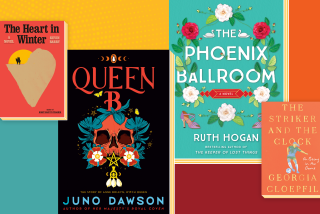DISCOVERIES
- Share via
HARPO’S GARDEN; By Roger Lee Kenvin; (July Blue Press: 118 pp., $12)
Here is a book with no publicity machine behind it. The stories between its pictureless blue covers are about growing up on Spanish Island, off the Maine coast, a place with a winter population of 1,500 that swells to 3,000 in the summer. Locals refer to the four seasons as Winter Wet, Winter Cold, Mud Slop and Tourists. The town store is run by Old Sims, whose politics are: “ ‘You voted for Clinton, didn’t you?’ Ben asks, surprised. ‘Can’t say as I did,’ says Sims, pushing up his glasses and smiling. ‘You mean you voted for Perot?’ says Ben. ‘I’m still looking for a New Englander,’ says Sims. ‘Haven’t had a good one since Kennedy.’ What about Bush, asks his interlocutor, ‘He’s got a big place down in Kennebunkport. . . .’ ‘Summer resident,’ says Sims. ‘That man can’t fish.’ ”
Kenvin’s tender memories of the place, of his little brother Harpo (particularly the sweet sad eulogy, “Harpo’s Garden”) who never smiles again after he comes back from Vietnam and Kenvin’s piano teacher (“she stationed herself behind me, like some sinister New England coatrack”) are full of heart and vinegar, nostalgia without hankering.
ALMOST AN ISLAND: Travels in Baja California; By Bruce Berger; (University of Arizona Press: 212 pp., $11.95)
It’s in Berger’s blood--a three decade obsession with the “eight hundred mile dead end” that is Baja California. Here is a wide-eyed writer with the curiosity, patience and observational skills to follow leads, pursue histories and apply the artistry that takes the reader down the same paths he visits. It’s like reading Marc Reisner’s “Cadillac Desert”: “Almost an Island” is about how humans contour and inhabit a place. But Berger writes without the density and showmanship that bog “Cadillac Desert” down in places. Nor does he conceal his love for Baja, which brims over in every chapter. There’s geology, natural history, religion, desert rats, environmental issues, Mexican politics, music and adventure. There’s disappointment and maturity and above all, humor.
Berger is clearly guided by the inner lizard that lives within all desert-lovers--scurrying in and out of crevices, basking upon rocks in the sun.
LOST AT SEA: An American Tragedy; By Patrick Dillon; (The Dial Press: 264 pp., $23.95)
It is thrilling to read about the risks that other people take, but not far beneath the thin layer of romance lies the banality, pointlessness and even stupidity that are so often the byproducts of those risks. We know this from gobbling up books like “The Perfect Storm,” “Into the Wild” and “Into Thin Air.” In the end, we feel smug about staying home, even as we felt envious of these lives when we first opened the books.
Patrick Dillon, former editor and columnist for the San Jose Mercury News, has written a gripping account of two crabbing vessels lost in the Bering Sea in 1983. As Sebastian Junger did in his description of Gloucester, Mass., Dillon’s portrait of the community these boats sail from, Anacortes in Washington, is rich, historic and compelling, like the sea itself. Generations are fed to the crabbing industry until it dries up. Risks are taken with marine safety regulations in the name of greed, and by the end of “Lost at Sea,” 14 new names are added to the 96 missing seamen whose names are inscribed on the obelisk on the Anacortes dock.
Dillon differs from Junger (perhaps because he is more of a journalist than a fiction writer) in his reticence to enter the minds of the lost fishermen. He does not, for example, include a hypothetical chapter depicting the moments before the boat went down. There is something fine and dignified about his refusal to take that risk and make those assumptions that makes “Lost at Sea” a better book than Junger’s, even more thrilling because it is more mysterious.
THE DREAM MISTRESS; By Jenny Diski; (The Ecco Press: 86 pp., $23.95)
The night before I started reading this book I dreamed the first scene: A woman wandering in a bad neighborhood passes a damp huddle of a human on the ground and calls an ambulance. That person turns out to be her mother, who left her when she was 10. I think I woke up, but the book continues on two parallel tracks, Mimi’s and her mother’s, that do not collide except for that brief moment in a bad London neighborhood late in their lives.
Diski writes from a private wilderness. Her language is cold and spikey, even as her plot is steamy, languid and subterranean. It’s one thing to write about pain and about mean, self-centered people and about lives given up mid-way and about abandonment in all its forms, and another to swim in that sea among those icebergs. Diski steers her novel safely through them but be forewarned: She is jarring and reckless in her mix of humour and emotional gore--a uniquely British recipe, reminiscent of Will Self or Jeanette Winterson.
THE MUSIC LESSON; By Katharine Weber; (Crown: 178 pp., $21)
The order in which information is presented in a novel is a lot like a bus route. The express plot gets you there quickly and predictably. The local makes all the stops; memories and possibilities and landscapes present themselves. With the right driver it seems an exciting adventure. A little less experience and it seems bumpy, coy and manipulative. The idea of course is to create something so seamless that the mechanisms that move the story forward disappear into the landscape. Weber drives the local, and it’s an open-ended journey, but you feel her changing gears.
Yet the ingredients of this novel are delightful: an art historian of Irish descent whose 5-year-old daughter has just been killed by a schoolbus and whose marriage has recently ended; an IRA gunman who is her long-lost cousin, enough removed; a stolen Vermeer (always a welcome addition to any plot); the Frick Museum in New York (the squeaky door in the butler’s pantry, Mr. Green with a lead pipe); a cottage on the west coast of Ireland.
Mix them together and what do you get? Exciting sex in the presence of great art. Loss and Discovery. Self reliance and conviction. As always, that legacy of the Irish soul, solitude.
More to Read
Sign up for our Book Club newsletter
Get the latest news, events and more from the Los Angeles Times Book Club, and help us get L.A. reading and talking.
You may occasionally receive promotional content from the Los Angeles Times.






